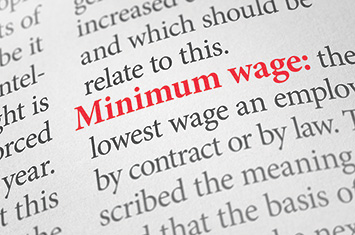 President Joe Biden has proposed raising the federal minimum wage to $15 an hour by 2025. The increase is long overdue – the federal minimum wage has not gone up since 2009. But there’s a lot of misinformation circulating about its perceived impact.
President Joe Biden has proposed raising the federal minimum wage to $15 an hour by 2025. The increase is long overdue – the federal minimum wage has not gone up since 2009. But there’s a lot of misinformation circulating about its perceived impact.
The Economic Policy Institute (EPI) estimates raising the minimum wage to $15 an hour would lift the pay of nearly 32 million U.S. workers. EPI is an independent, Washington-based think tank that researches the impact of economic trends and policies on working people in the United States.
LESS NEED FOR PUBLIC ASSISTANCE
The EPI report estimates that if the Raise the Wage Act passed and the federal hourly minimum wage increased to $15 by 2025:
- Annual government expenditures on major public assistance programs would fall by between $13.4 billion and $31 billion.
- Earned income tax credit (EITC) and child tax credit (CTC) expenditures would decline by somewhere between $6.5 billion and $20.7 billion annually.
- Expenditures on the Supplemental Nutrition Assistance Program (SNAP) and other major government transfers would fall by between $5.2 billion and $10.3 billion annually.
- Reduced annual expenditures on SNAP alone would range from $3.3 billion to $5.4 billion.
INCREASE FEDERAL TAX REVENUE
The report also estimates raising the federal minimum wage to $15 by 2025 would increase annual Federal Insurance Contributions Act (FICA) revenue by between $7 billion and $13.9 billion annually.
“A significant increase in the minimum wage has really direct and significant fiscal effects, through a number of easily-identifiable channels,” said EPI Senior Analyst David Cooper. “Higher wages lead to workers qualifying less frequently for public benefits and often receiving less even when they do qualify. They also boost tax revenue.”
LIFT PAY FOR 32 MILLION WORKERS
Raising the federal minimum wage to $15 an hour by 2025, would lift pay for nearly 32 million workers across the country (21 percent of the U.S. workforce), EPI concludes, and provide an additional $107 billion in wages for the country’s lowest-paid workers, with the average affected worker who works year-round receiving an extra $3,300 a year.
EPI researchers have created an interactive map providing specific details on the impact of the proposed increase in each state. The map can be found at epi.org/publication/minimum-wage-to-15-by-2025-by-congressional-district.

The chart illustrates the potential impact raising the minimum wage to $15 an hour would have on workers in our region’s congressional districts.


